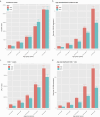Global, Regional, and National Burden of Gastric Cancer in Adolescents and Young Adults, 1990-2019: A Systematic Analysis for the Global Burden of Disease Study 2019
- PMID: 37800697
- PMCID: PMC10904006
- DOI: 10.14309/ajg.0000000000002551
Global, Regional, and National Burden of Gastric Cancer in Adolescents and Young Adults, 1990-2019: A Systematic Analysis for the Global Burden of Disease Study 2019
Abstract
Introduction: Gastric cancer is a significant global health concern, ranking as the fifth most common cancer worldwide and the third leading cause of cancer-related mortality. While improvements in health awareness and medical technology have contributed to a decline in the incidence of gastric cancer in many countries, the rate of gastric cancer in adolescents and young adults (GCAYA) has shown an upward trend. Timely and effective strategies for screening, detection, and treatment are crucial for managing the burden of GCAYA and optimizing the allocation of medical resources. To this end, our study aimed to examine the distribution of the burden of GCAYA across different factors at the global, regional, and national levels between 1990 and 2019. By identifying and analyzing these factors, we can better inform efforts to combat this growing health challenge.
Methods: This study used data from the Global Burden of Disease database to analyze the global, regional, and national incidence, mortality, and disability-adjusted life years (DALY) GCAYA from 1990 to 2019. The age-standardized incidence rate (ASIR), age-standardized mortality rate, and age-standardized DALY rate (ASDR) of GCAYA were summarized and presented in a visually intuitive manner at the global, regional, and national levels. In addition, we calculated the estimated annual percentage change for each indicator of GCAYA globally, regionally, and nationally and visually displayed the results. Furthermore, we conducted an age-based analysis of adolescents and young adults with gastric cancer, comparing the age composition of deaths and the age burden of patients between 1990 and 2019. For the sake of brevity, we will use the abbreviation GCAYA to refer to gastric cancer among adolescents and young adults throughout the remainder of this article.
Results: From 1990 to 2019, the incidence of GCAYA has slightly increased globally. The number of newly diagnosed cases rose from 47,932 (95% uncertainty interval 44,592.9-51,005.7) in 1990 to 49,007 (45,007.7-53,078.1) in 2019, while the number of deaths decreased from 35,270 (32,579-37,678.5) to 27,895 (25,710.9-30,240.4). The global ASIR showed a declining trend, decreasing from 22.4 (95% uncertainty interval 21.2-23.6) per 100,000 in 1990 to 15.6 (14.1-17.2) per 100,000 in 2019. The age-standardized mortality rate also showed a declining trend, decreasing from 20.5 (19.2-21.6) per 100,000 in 1990 to 11.9 (10.8-12.8) per 100,000 in 2019. The ASDR also showed a declining trend, decreasing from 493.4 (463.7-523.7) per 100,000 in 1990 to 268.4 (245.5-290.6) per 100,000 in 2019. From 1990 to 2019, the incidence, mortality, and DALY of gastric cancer among male adolescents and young adults were higher than those of female adolescents and young adults. In 2019, the number of male adolescents and young adults with gastric cancer was 2.1 times higher than that of female individuals (368.9 [328.2-410.3] vs 178.2 [160.5-196.9]), the number of deaths was 1.1 times higher (14,971.6 [13,643.3-16,520.5] vs 12,923.6 [11,550.3-14,339]), and the DALY were 1.1 times higher (841,920.5 [766,655.5-927,598.8] vs 731,976.3 [653,421-814,242.8]). The incidence and DALY of GCAYA were higher in regions with high-middle and middle sociodemographic index countries. The age-standardized mortality rate of GCAYA in 198 countries and territories showed a decreasing trend, with the Republic of Korea showing the greatest decrease from 1,360.5 (1,300.3-51,416.5) per 100,000 in 1990 to 298.7 (270.1-328.4) per 100,000 in 2019, with an estimated annual percentage change of -5.14 (95% confidence interval -7.23 to -2.99). The incidence and DALY of GCAYA increased with age, with the highest proportion of patients being in the 35-39 years age group. In both 1990 and 2019, the age of death from GCAYA was mainly concentrated in the 35-39 years age group, accounting for approximately half of the total population.
Discussion: In the past 30 years, although the total number of new cases of GCAYA has increased with population growth, the ASIR and overall disease burden have shown a decreasing trend. This indicates progress in screening, diagnosis, treatment, education, and awareness efforts. However, the distribution of this disease remains uneven in terms of sex, age, development level, region, and country. To address these challenges, global health authorities should take appropriate measures such as optimizing screening programs, strengthening awareness and screening efforts for male individuals, enhancing prevention and control among the 35-39 years age group, improving infrastructure and health care resources in developing countries, promoting international cooperation, and implementing tailored measures.
Copyright © 2023 The Author(s). Published by Wolters Kluwer Health, Inc. on behalf of The American College of Gastroenterology.
Conflict of interest statement
Figures





References
-
- Smyth EC, Nilsson M, Grabsch HI, et al. . Gastric cancer. Lancet 2020;396(10251):635–48. - PubMed
-
- Wen J, Shen H. Trend of gastric cancer incidence and death rate in adolescents and young adults: A retrospective cohort study based on the surveillance, epidemiology, and end results (SEER) database. J Gastroenterol Hepatol 2023;38(3):393–403. - PubMed
Publication types
MeSH terms
Grants and funding
LinkOut - more resources
Full Text Sources
Medical
Miscellaneous

